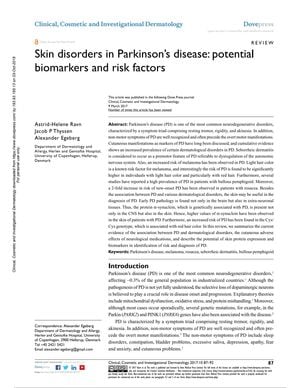Skin Disorders in Parkinson’s Disease: Potential Biomarkers and Risk Factors
March 2017
in “
Clinical, cosmetic and investigational dermatology
”

TLDR Certain skin conditions may indicate or increase the risk of Parkinson's disease.
The 2017 review discussed the relationship between Parkinson's disease (PD) and skin disorders, suggesting that certain dermatological conditions could be biomarkers or risk factors for PD. Seborrheic dermatitis was identified as a possible premotor symptom of PD, and there was an observed increased risk of melanoma in PD patients, especially those with light hair colors like red. The review also noted a high prevalence of PD in patients with bullous pemphigoid and a 2-fold increase in PD risk in patients with rosacea. The presence of the protein α-synuclein in the skin was proposed as a potential biomarker for PD, with one study finding significantly higher levels in the skin biopsies of 17 PD patients compared to 17 healthy individuals. Another study with 279 patients, 85 with Lewy Body pathology, found dermal α-synuclein immunoreactivity in 23.5% of those with Lewy Body pathology. The review emphasized the need for further research to clarify these associations and suggested that skin biopsies might be a future diagnostic tool for PD. Conflicts of interest were disclosed, with authors receiving funding or honoraria from pharmaceutical companies.
